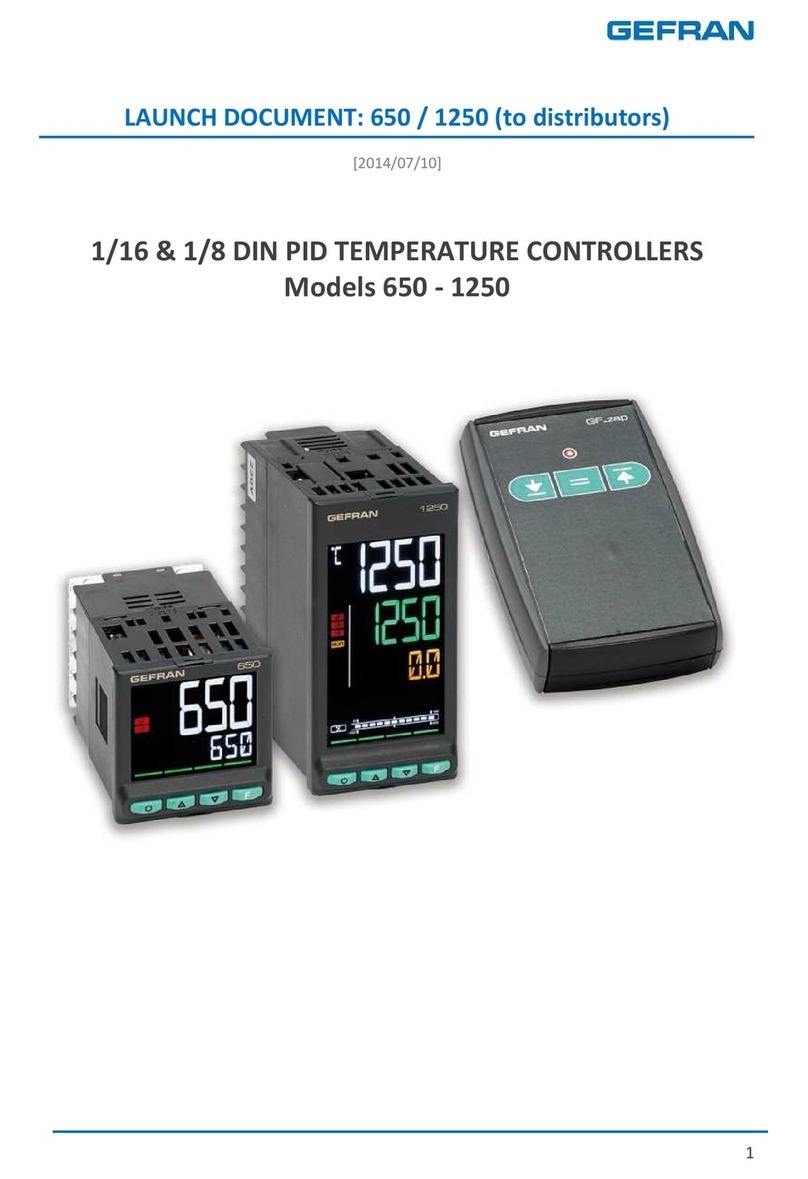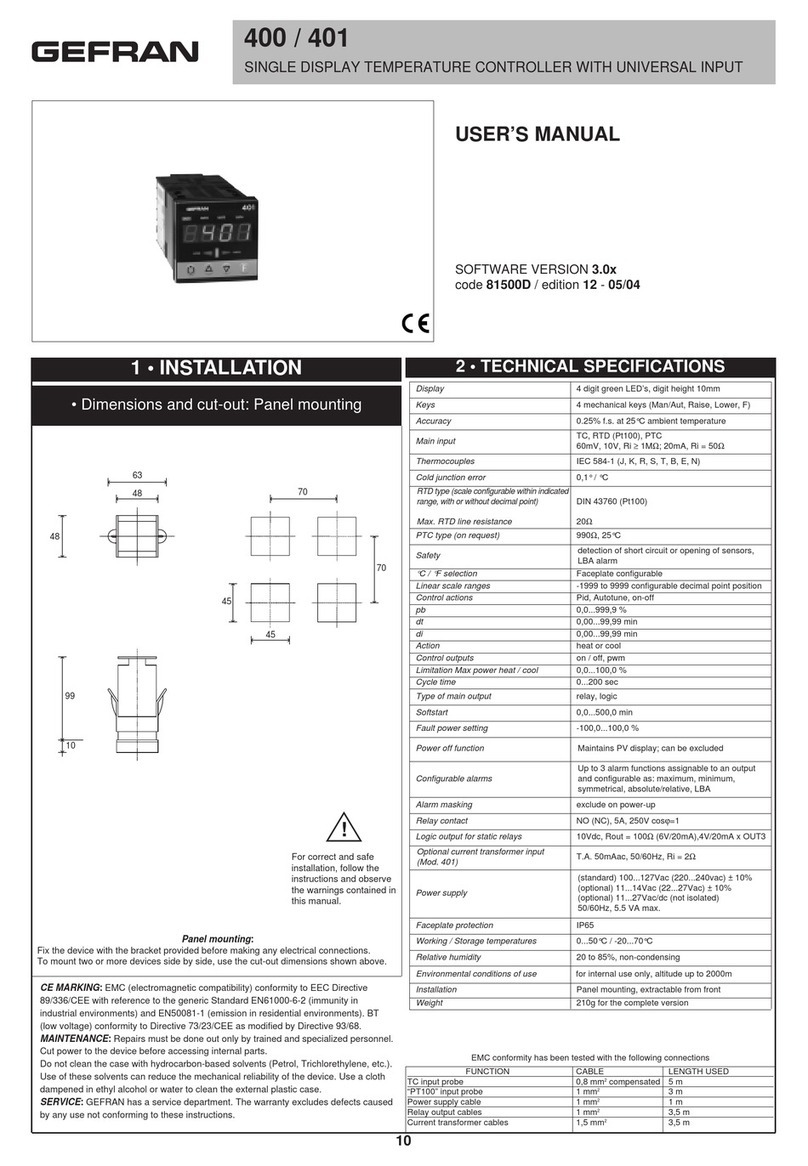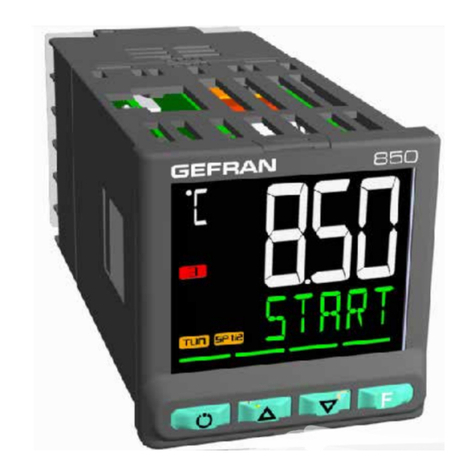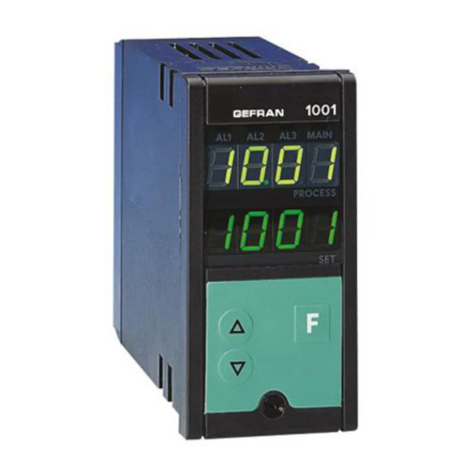Operator Interface
All the operator interface devices are concentrated
on the controller faceplate, suitably protected by a mem-
brane in Lexan that guarantees IP65 level protection.
• 4buttonstobeusedformanualregulation/
configuration/selection
• 2greenfour-digitdisplays
(Process Variable and Set point Variable)
• 4redLEDsforstatusindicationofsamenumberof
relay/logic outputs
• 3LEDswithprogramfunctiontoindicatecontroller
operating mode.
Electrical Interface
All connection terminals (power supply, inputs, outputs,
options) are grouped together on the back of the
controller.
For technical specifications and performance details
refer to Section 5 “Technical Specifications”.
Preliminary Warnings
The following preliminary warnings should
be read before installing and using the series
1200/1300 controller . This will allow the control-
ler to be put into service more quickly and will
avoid certain problems which may mistakenly
be interpreted as malfunctions or limitations of
the controller.
• Immediatelyafterunpackingthecontroller,makea
note of the order code and the other identification
data given on the label affixed to the outside of the
container and copy them to the table below.
These details must always be kept close at hand and
referred to the personnel involved in the event of
help from Gefran Customer Service Assistance.
• Checkalsothatthecontrolleriscompleteandhas
not been damaged at all during transit, and that the
package contains not only the controller and these
Instructions for Use, but also the two brackets for
fixing to the panel and the dust protection seal - see:
Installation with Panel Fixing in Section 2.
Any inconsistencies, omissions or evident signs of
damage should be reported immediately to your
Gefran sales agent.
• Checkthattheordercodecorrespondswiththe
configuration requested for the application the
controller is needed for, referring to Section 7:
“Technical - Commercial Information”.
• No.andTypeofInputs/Outputsavailable
• Presenceofthenecessaryoptionsand
accessories
• Mainsvoltagesupply
Example: 1200 – RT – RR – 00 – 0 – 1
Model 1200 controller
Output 1 - Relay; Output 2 - Triac (1A)
Output 3 - Relay; Output 4 - Relay
No Digital Input
No Digital Communication
Mains Voltage 100...240Vac/dc
• Beforeinstallingtheseries1200/1300controlleron
the control panel of the machine or host system,
refer to the paragraph “Dimensions and Cut-out” in
Section 2 “Installation and Connection”.
• WhereconfigurationbyPCisprovidedfor,make
sure the interface RS232 cable is available and the
CD- ROM containing the WINSTRUM software.
For the order code refer to Section 7 “Technical -
Commercial Information”.
Users and/or system integrators who wish
to know more about the concepts of serial com-
munication between standard PC and/or
Gefran Industrial PC and Gefran Programmable
Instruments (including the series 1200/1300
controller), can access the various technical
reference Documents in Adobe Acrobat format
available in the Download section of the Gefran
Web Site www.gefran.com including:
•SerialCommunication
•MODBusProtocol
In the same Download section of the Gefran
Web Site www.gefran.com the 1200/1300
Temperature Controller reference manual is
available in Adobe Acrobat format, containing a
detailed description of all the adjustable
parameters and procedures for the Controller.
In the event of presumed instrument malfunction,
before contacting Gefran Technical Service
Assistance, refer to the Troubleshooting Guide
given in Section 6 “Maintenance”, and if
necessary refer to the F.A.Q. Section (Frequently
Asked Questions) on the Gefran Web Site
www.gefran.com
SN: ......................... (Serial no.)
CODE: ......................... (Finished product code)
TYPE: ......................... (Order Code)
SUPPLY: ......................... (Type of electrical power supply)
VERS: ......................... (Software version)
3
81801G_MHW_1200-1300_07-2011_ENG
































